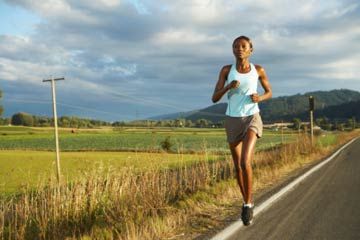After miles of running on your heels, it's the end of the race and the finish line is in sight. It's time for an all-out sprint, so you furiously pump your arms and mightily drive forward in hopes of shaving a few seconds off your finish time. During this final push, you're probably doing something you haven't done much of throughout the race -- toe-running. Well, sort of.
Toe-running is a popular term, but it's a misnomer since few people run exclusively on their toes. More accurately, it's called forefoot striking. Whatever the name, it's one of three primary strikes that distance runners utilize:
Advertisement
- Heel -- The heel strikes first and rolls onto the forefoot.
- Mid-foot -- The strike occurs somewhere between the forefoot and heel with both effectively landing at once.
- Forefoot -- The ball of the foot hits first then rolls on to the heel.
[Source: Lieberman et al]
While it's common to run using more than one type of strike, most runners heel strike the majority of the time. A 2007 study observed that 74.9 percent of runners in a particular half-marathon primarily used heel strikes [source: Hasegawa et al]. But several newer running styles have popularized alternative strikes. Chi Running combines concepts from Tai Chi with a mid-foot striking pattern [source: Dreyer]. The Pose Method advocates running with an erect posture and landing on the ball of the foot [source: Pose Tech].
And then there are barefoot runners. Barefoot runners often argue that humans are intended to land on the forefoot when running, just as our hunter-gatherer ancestors did. Folks in the barefoot camp think that the heel striking required by modern running shoes has contributed to injuries and inefficiencies. The best way to return to form, they say, is to shed your shoes.
Whether you agree or disagree with the barefoot crowd, know this: A shoe-clad runner can toe-run just as well as a barefoot runner. In fact, Paula Radcliffe and Haile Gebrselassie -- the current female and male marathon world record holders -- are forefoot strikers who run in shoes. A shoeless Abebe Bikila won the marathon at the 1960 Olympics with forefoot strikes and issued a repeat performance with Pumas on his feet in 1964 [source: Olympics]. (It's also worth noting that many elite runners run with a heel strike.)
So your preference for footwear (or lack thereof) is no barrier to giving forefoot striking a go. Click ahead to find out how to make the transition.
Advertisement



